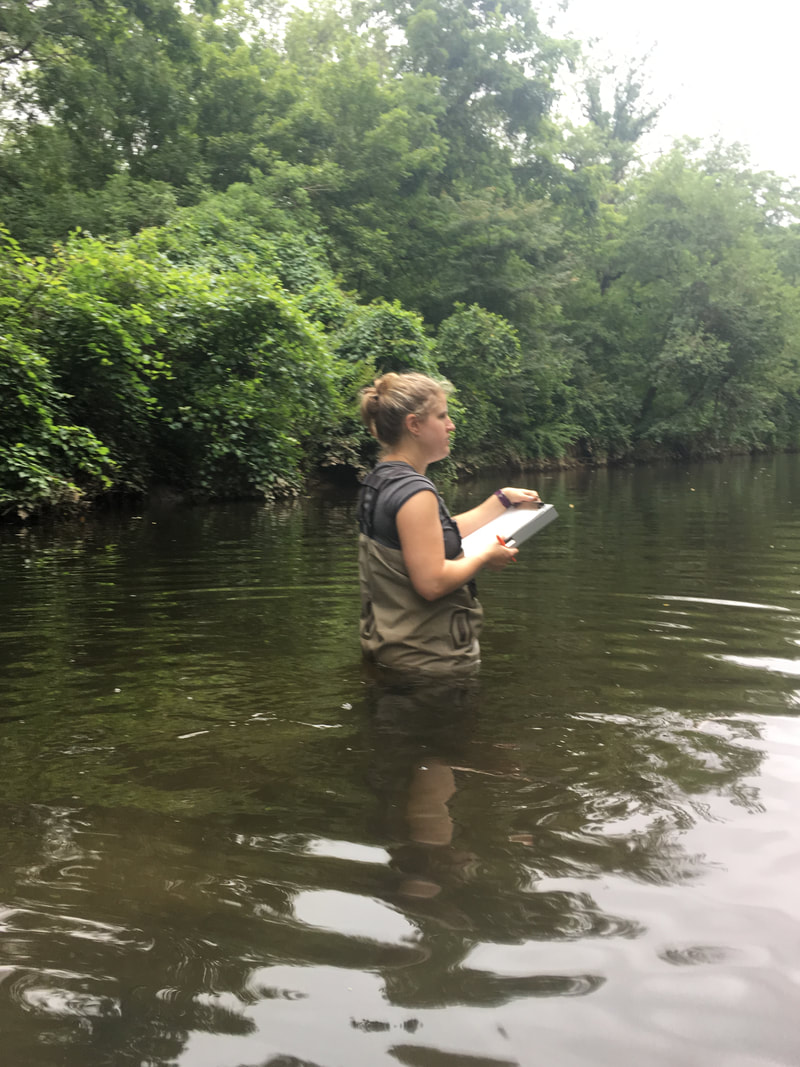The interaction between ecological processes and water quality and quantity. How does the ecology of a system (from microbes to mega-fauna to algae to trees) impact where water is coming from, the timing of the water, the associated dissolved (and particulate…and bigger!) material in that water, and where that water and material in the water end up! I think it’s important to frame ecohydrology as a topic to be studied for all fluxes and reservoirs of the hydrologic cycle.
What are your undergraduate and graduate degrees in?
I have a BA in Earth Science from Vassar College and a PhD in Earth Science from Syracuse University.
How did you arrive at working in/thinking about ecohydrology?
As for many of us, running around in streams, picking up rocks, and poking bugs was one of my main past-times, even in high school, because I grew up in the suburbs. My sub-topic of ecohydrology really focuses on anthropogenic impacts, so Walter and Merritts’ 2008 paper on the impact of mill-dam ponds on sediment legacies and stream structure what the paper that made the light-bulb go off for me- I wanted to understand what humans have changed about rivers and streams. My undergraduate department was small, so we didn’t have hydrology, and given our location in the Hudson Valley, geomorphology really focused on glacial impacts. This paper was the one that made me think about how large our physical impact has been on the landscape, even in places we think are ‘natural’. After reading this paper, I worked on an honor’s thesis that looked at the impact remanent ponds on my campus had on DIN. It was a massive failure, but the questions about human impacts on water chemistry persisted! When I got to graduate school, my advisor’s main specialty at that point was hyporheic exchange, but we started sampling a local stream for a field method’s class and found some fascinating patterns. My PhD work evolved into digging into those patterns to figure out their drivers (which end up being strongly controlled by anthropogenic impacts on surface water-groundwater interactions). Since then, my work has expanded to think about other systems where human influence dominates (small streams receiving wastewater treatment plant effluent for my post-doc and extremely urbanized environments now in Atlanta).
What do you see as an important emerging area of ecohydrology?
High-temporal loggers and the massive collection of data without understanding what we are collecting and the questions we are asking (and I’m guilty here, too!). There have been some great calls-to-arms on this, including Burns et al. 2019 in WIRES Water. Suddenly the world is pretty wide open as far as data collection goes, but I think we need to step back, make sure we are framing solid questions, before we dive in. We also need to acknowledge how much ‘bad’ data may be collected and separate it from ‘data that does not make sense’. ‘Bad’ data are due to poor QAQC, poor siting, etc., and really can’t be used. ‘Data that does not make sense’ are much more exciting and will lead to new questions! And, I think there are important regulatory implications for high-temporal data: when we suddenly see how much daily variation there is in water quality, how can we best advise a sampling regime that measures the over-all health of a system? Have we been mis-representing the health of systems from grab samples? Does this start to explain the disconnect between ecological indicators of health we’ve seen in cities (such as poor EPT counts) despite the fact that our water quality is ‘improving’?
Do you have a favorite ecohydrology paper? Describe/explain.
I love AJ Reisinger and all’s 2019 Ecological Applications paper about the impact of stream restoration on in-stream metabolism. It is such a clear example of how people have gone in, ‘fixed’ a problem, but not thought about the other ecological implications of their ‘fix’ (in this case, removal of riparian vegetation and the impact increased light availability has on the stream). And on the opposite side of the argument, Pennino et al 2014 (in Biogeochemistry) thinks about the impact stream burial and removal of light has had in cities!
What do you do for fun (apart from ecohydrology)?
Talk long walks around Atlanta with my dog, drink beer around a fire-pit, read books, and watch too much TV! I also love to cook and try new recipes. And as a new home-owner, I’m up to my elbows in small home improvement projects, especially getting garden beds up and running and working on building raised beds for tomatoes!

 RSS Feed
RSS Feed